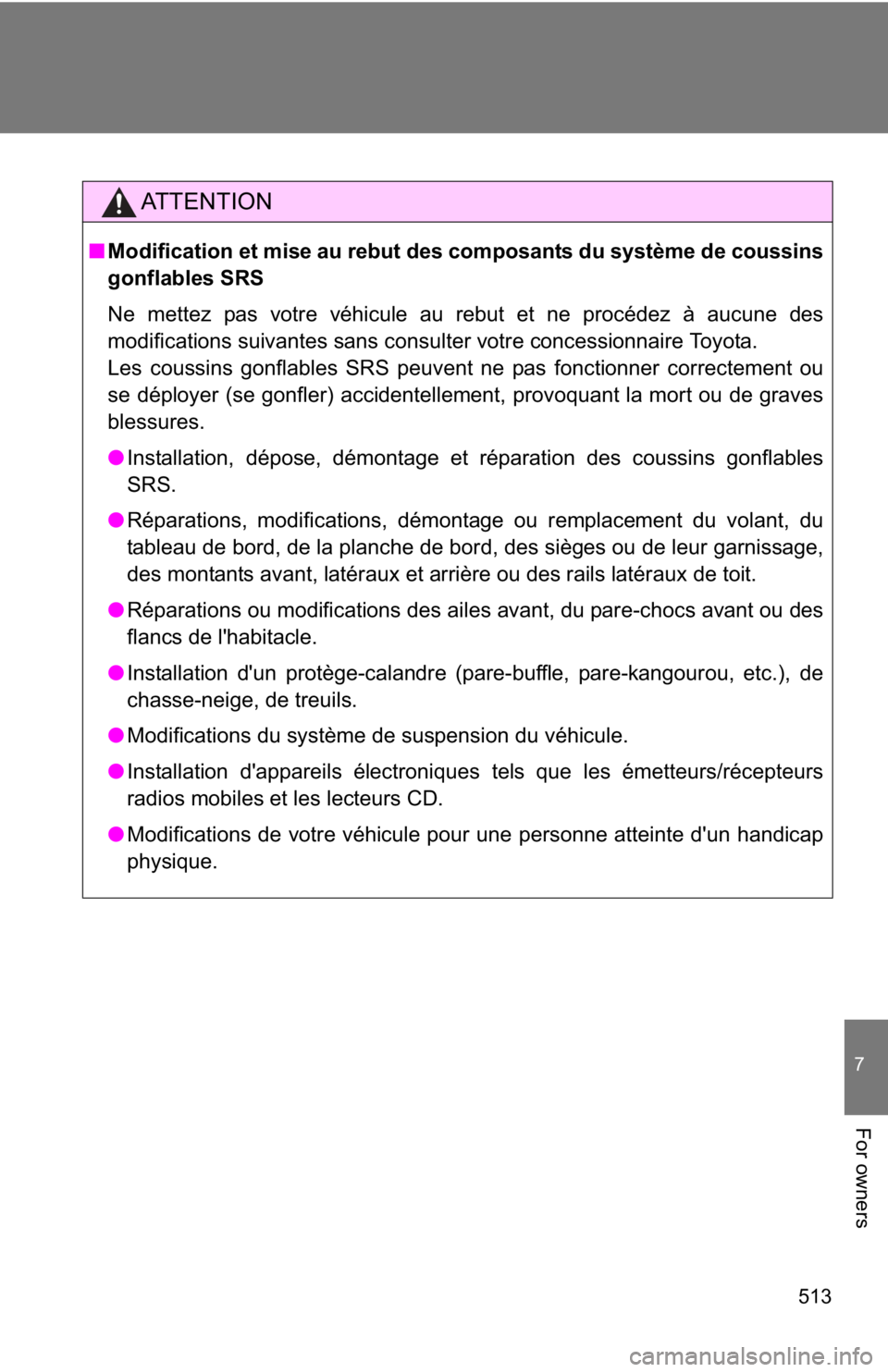Page 124 of 532

124 1-7. Safety information
WARNING
■SRS airbag precautions
●Do not touch any of the component parts immediately after the S RS air-
bags have deployed (inflated) as they may be hot.
● If breathing becomes difficult after the SRS airbag has deploye d, open a
door or window to allow fresh air in, or leave the vehicle if i t is safe to do
so. Wash off any residue as soon as possible to prevent skin ir ritation.
● If the areas where the SRS airbags are stored, such as the stee ring wheel
pad and front and rear pillar garnishes, are damaged or cracked, have
them replaced by your Toyota dealer.
■ Modification and disposal of SRS airbag system components
Do not dispose of your vehicle or perform any of the following modifications
without consulting your Toyota dealer.
The SRS airbags may malfunction or deploy (inflate) accidentall y, causing
death or serious injury.
● Installation, removal, disassem bly and repair of the SRS airbag s.
● Repairs, modifications, removal or replacement of the steering wheel,
instrument panel, dashboard, seats or seat upholstery, front, side and rear
pillars or roof side rails.
● Repairs or modifications of the front fender, front bumper, or side of the
occupant compartment.
● Installation of a grille guard (bull bars, kangaroo bar, etc.), snow plows,
winches.
● Modifications to the vehicle's suspension system.
● Installation of electronic devices such as mobile two-way radios and CD
players.
● Modifications to your vehicle for a person with a physical disa bility.
Page 136 of 532

136 1-7. Safety information
WARNING
■Front passenger occupant classification system precautions
●Never install a rearward facing child seat in the front passeng er’s seat
even if the front passenger’s SRS frontal airbag is deactivated . Be sure to
install it in the rear seat in a correct manner. Also, it is strongly recom-
mended that any forward facing child seat or booster seat be in stalled in
the rear seat, and that even children who have outgrown a child restraint
system be also seated in the rear seat. This is because childre n sitting in
the front passenger’s seat may be killed or severely injured should the
front passenger’s SRS frontal airbag deploy. Toyota believes th at the rear
seats are the safest place for children
● If luggage or electronic devices are placed on the front passen ger seat,
the OFF indicator may turn off and the ON indicator may illumin ate. If this
occurs, the front passenger’s airbag may deploy during a collision. If this is
not desirable, remove the luggage or electronic devices from th e front pas-
senger seat.
● Modifications for persons with disabilities that may affect the front passen-
ger occupant classification system. (U.S. only) Removing, repla cing or
modifying any parts of the front seats, seat belts, front bumpe r, front side
frame, instrument panel, combination meter, steering wheel, ste ering col-
umn, tires, suspension or floor panel can affect the operation of the Toyota
front passenger occupant classification system.
Page 311 of 532

311
4-1. Maintenance and care
4
Maintenance and care
NOTICE
■
Cleaning the exterior lights
●Wash carefully. Do not use organic substances or scrub with a h ard brush.
This may damage the surfaces of the lights.
● Do not apply wax on the surfaces of the lights.
Wax may cause damage to the lenses.
■ To prevent damage to th e windshield wiper arms
When lifting the wiper arms away from the windshield, pull the driver side
wiper arm upward first, and repeat for the passenger side. When returning
the wipers to their original position, do so from the passenger side first.
■ When using a high pressure car wash
●Do not bring the nozzle tip close to boots (rubber or resin manufactured
cover), connectors or the following parts. The parts may be dam aged if
they come into contact with high-pressure water.
• Traction related parts
• Steering parts
• Suspension parts
• Brake parts
● Keep the cleaning nozzle at least 11.9 in. (30 cm) away from the vehicles
body. Otherwise resin section, such as moldings and bumpers, ma y be
deformed and damaged. Also, do not continuously hold the nozzle in the
same place.
● Do not spray the lower part of the windshield continuously.
If water enters the air conditioning system intake located near the lower
part of the windshield, the air conditioning system may not ope rate cor-
rectly.
Page 394 of 532

394
5-1. Essential information
If you think something is wrong
If you notice any of the following symptoms, your vehicle proba bly
needs adjustment or repair. Cont act your Toyota dealer as soon as
possible.
■ Visible symptoms
●Fluid leaks under the vehicle
(Water dripping from t he air conditioning after use is normal.)
● Flat-looking tires or uneven tire wear
● Vehicles with a monochrome multi-information display: The
engine coolant temperature gauge needle continually points
higher than normal
● Vehicles with a color multi-information display: The high
engine coolant temperature wa rning light flashes or illumi-
nates
■ Audible symptoms
●Changes in exhaust sound
● Excessive tire squeal when cornering
● Strange noises related to the suspension system
● Pinging or other noises related to the engine
■ Operational symptoms
●Engine missing, stumbling or running rough
● Appreciable loss of power
● Vehicle pulls heavily to one side when braking
● Vehicle pulls heavily to one side when driving on a level road
● Loss of brake effectiveness, s pongy feeling, pedal almost
touches the floor
Page 513 of 532

513
7
For owners
AT T E N T I O N
■Modification et mise au rebut des composants du système de coussins
gonflables SRS
Ne mettez pas votre véhicule au rebut et ne procédez à aucune des
modifications suivantes sans consulter votre concessionnaire Toyota.
Les coussins gonflables SRS peuvent ne pas fonctionner correctement ou
se déployer (se gonfler) accidentellement, provoquant la mort ou de graves
blessures.
● Installation, dépose, démontage et réparation des coussins gonflables
SRS.
● Réparations, modifications, démontage ou remplacement du volant, du
tableau de bord, de la planche de bord, des sièges ou de leur garnissage,
des montants avant, latéraux et arrière ou des rails latéraux de toit.
● Réparations ou modifications des ailes avant, du pare-chocs avant ou des
flancs de l'habitacle.
● Installation d'un protège-calandre (pare-buffle, pare-kangourou, etc.), de
chasse-neige, de treuils.
● Modifications du système de suspension du véhicule.
● Installation d'appareils électroniques tels que les émetteurs/récepteurs
radios mobiles et les lecteurs CD.
● Modifications de votre véhicule pour une personne atteinte d'un handicap
physique.